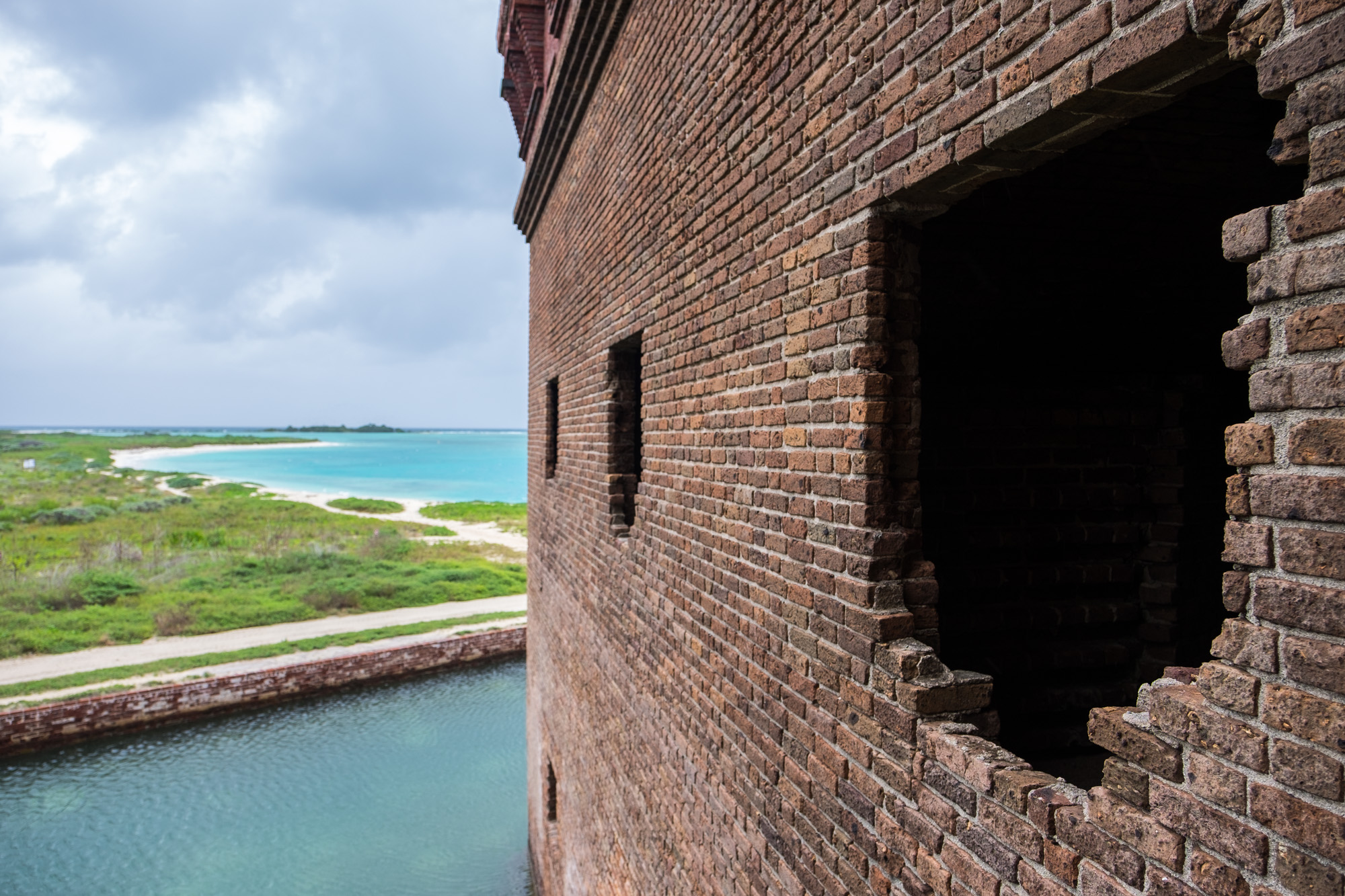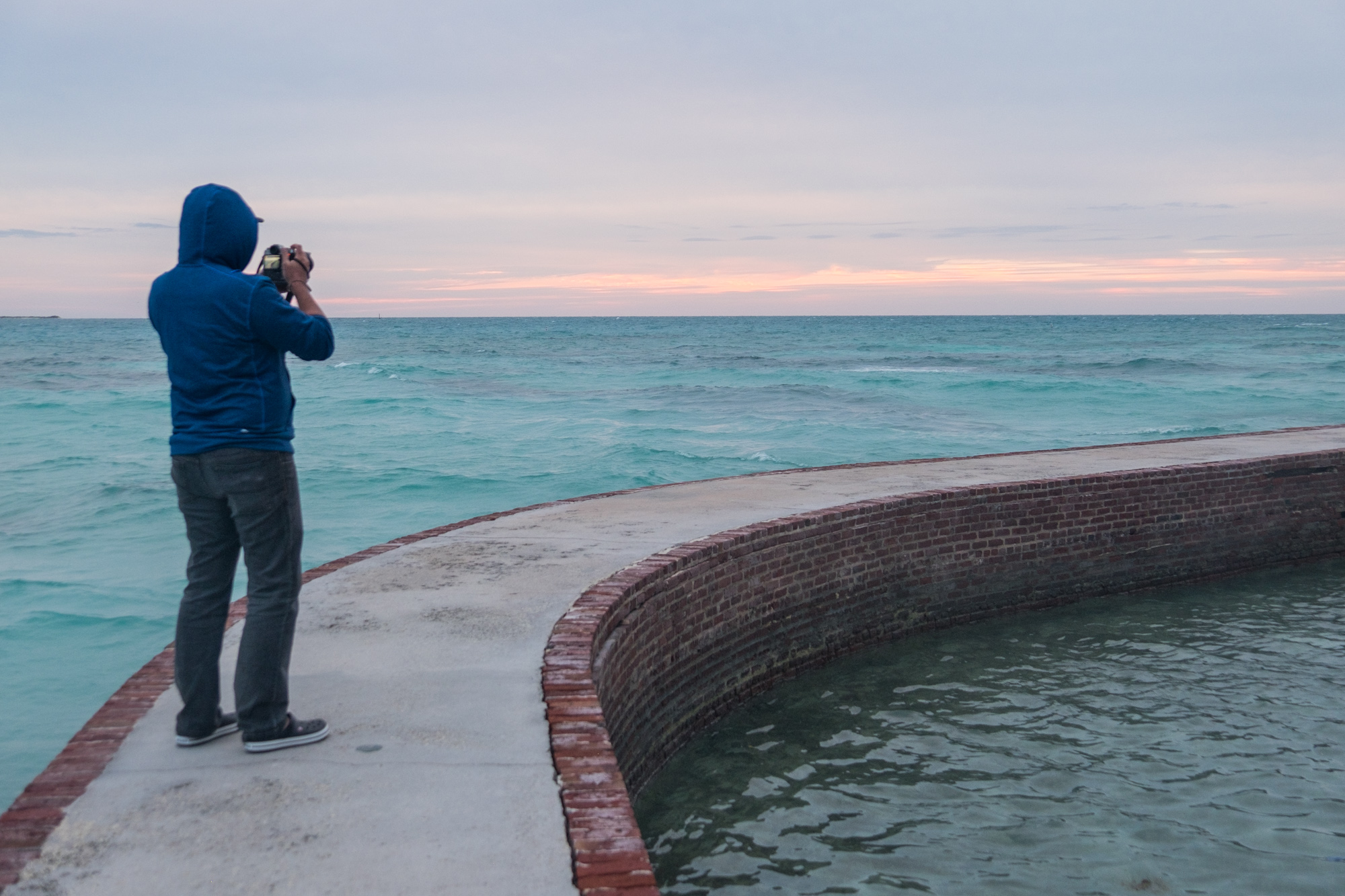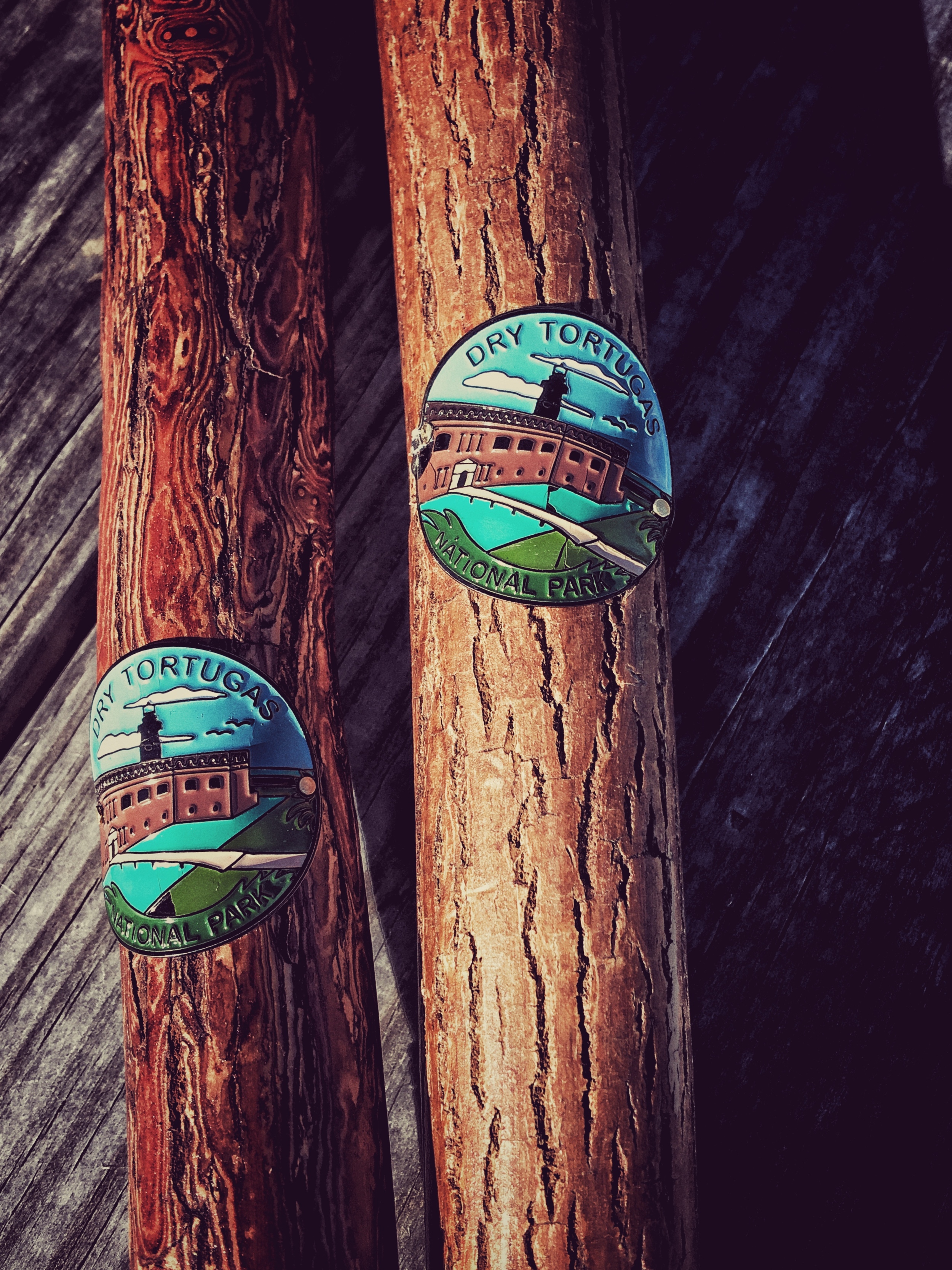Dry Tortugas National Park, Florida, USA | Park 3/59
The moat wall crossing right into our beachside campsite. Credit: Jonathan Irish
Primitive Camping at the Dry Tortugas
Ideally, the route along the Greatest American Road Trip should coincide with park seasonality. While we would love to be able to visit the national parks when they are at their best in terms of weather, there are simply too many to visit during the span of one year to make this possible. Even places in sunny Florida, for example, hibernate during low season—October through April. Dry Tortugas off of Key West is no exception. Ranger Mike who lives there full time told us that they typically wear long-sleeved shirts only about three days per year ... we were there for all of them.
The Yankee Freedom III brings day trippers and campers daily 70 miles from Key West to the shores of Garden Key. Credit: Jonathan Irish
Our initial plan for Dry Tortugas was to explore the island on our new inflatable stand up paddleboards, which we toted along with us. Mother Nature, in her chameleon and headstrong ways, had different plans for us. Day after day and night after night the wind bellowed and howled from the coastline and the wind bellowed and howled right back from inside the fort, and the ocean hissed at them both. We existed somewhere among them.
The Daily News! These birds don't mind the crazy weather so much. Credit: Jonathan Irish
Being that nature is a rain-or-shine event, we improvised. We camped three nights on Garden Key as planned, allowing us five full days to explore as a result of the Yankee Freedom III ferry schedule. We took long wanders through massive Fort Jefferson—the crown jewel of the National Park—as most whom visit the island do. The long corridors of brick archways, expansive views of the sea from the roofline, and the moat wall can captivate anyone’s attention for many hours (and the protection it provided us from the elements did not go unnoticed.) Away from the fort, the keys were brimming with life as migrating land- and seabirds gathered as they do every year, including a colony of 100,000 Sooty Terns who formed a strangely beautiful black cloud overhead. We passed the rain spells by playing rummy, and by creating new ways to entertain ourselves—namely a pastime that we like to call catching up with the Daily News, a game of storytelling that involved assigning personas to the migrating seabirds as they compete for wooden perches rising up from the water. It’s an easy game and anyone can play, and it is especially fun after completing another effort, dubbed Operation Yankee Freedom. Every day from 10:30-3pm, the Yankee Freedom vessel shows up at the island bringing day trippers in from Key West, and during that time, campers like us are welcomed to use the plumbed restroom (the hand dryer is a wonderful hand warmer) and buy beer aboard. It turns out that camping + beer + birds = fun in bad weather.
Ranger Mike had us laughing from the moment we arrived until the moment we left the Tortugas. He is a great example of how the Park Service enriches our experiences while in the parks. Credit: Jonathan Irish
All things considered, this unexpected weather gave us an opportunity to get to know the park in a unique way, bony legs and all. The unique position of being completely wired out and completely exposed to the elements allowed us to return to humanity for a minute. It’s incredible how experiences are altered completely when there is no wifi, and nobody around save a few quiet campers also hiding out and rangers living somewhere in the fort.
We sincerely hope to return when it’s warmer so we can take up some of the gems of the island lost on us during our visit—snorkeling pristine coral reefs found in shipwrecks such as the famed Windjammer; kayaking to Loggerhead Key located three miles from the fort, and of course, paddling the perimeter in search of the famed Tortugas (turtles) for which the island is named.
Quotable Images
Fact Box
7 islands | 64,700 acres | 70 miles west of Key West
Official name: Dry Tortugas National Park
Established: January 4, 1935
Location: Florida Keys, United States
How the park got its name: Spanish explorer Juan Ponce de León led an expedition resulting in the discovery of the islands in 1513. With a wealth of turtles, he naturally named the island the Spanish, Las Tortugas (The Turtles). After discovering that there were no freshwater springs, the name adapted to include Dry so that other mariners would know this to be a dry island before going there.
Iconic site in the Park: Fort Jefferson. The fort, one of the largest ever built, is the crown jewel of the Keys. While wandering the expansive grounds, a sense of history floods through you while you explore the remnants of this Civil War era prison. It was originally built in 1846 to protect deep-water anchorages in North America, providing safe harbor for ships patrolling the Gulf of Mexico to resupply, rest, and seek refuge from storms at sea. Construction continued until 1875 when it stalled out because of the war. There are more than 2,000 archways, and endless photography opportunities inside the fort. And outside, nature.
Accessible adventure: Day trip on the Yankee Freedom. This fast-speed catamaran, the official park service ferry, transports guests 70 miles from Key West in only 2.5 hours to one of the most remote National Parks in the Park System. When you arrive, you can break off and explore on your own (snorkel, swim, paddle, wander, etc.) or join the expert rangers and guides for a tour. Actually, there is time to do both.
Big adventure: Primitive camping on Dry Tortugas. While there is awesome adventure found in recreation on the island, including snorkeling coral reefs, kayaking to nearby Loggerhead Key, and paddle boarding the intensely green waters--the one big adventure that opens the doors to all others is camping on the island. After the boat or seaplane that carries you in leaves for the day, you have the island to yourself, a small handful of other campers, and helpful rangers who open up to you the back story with evening fortress walks and a more immersed experience.
Did you know?
Dry Tortugas is one of the most remote parks in the National Park System and is accessible only by high-speed ferry (Yankee Freedom), private and charter boats, and seaplane.
The islands of the Dry Tortugas are constantly moving and reshaping as a result of weather and erosion. According to the NPS website for Dry Tortugas, "entire islands have been know to disappear or reform following the passage of particularly violent hurricanes."
Loggerhead Key, sitting three miles from Fort Jefferson, has been home to The Carnegie Institute's Laboratory for Marine Biology was established in the Dry Tortugas in 1905, laying the foundation for tropical marine science research in the western hemisphere.
Learn more about Dry Tortugas National Park on the FAQ page of the National Park Service (NPS) official site.
Dry Tortugas National Park Map
“‘His stories were what frightened people worst of all. Dreadful stories they were—about hanging, and walking the plank, and storms at sea, and the Dry Tortugas, and wild deeds and places on the Spanish Main. By his own account he must have lived his life among some of the wickedest men that God ever allowed upon the sea, and the language in which he told these stories shocked our plain country people almost as much as the crimes that he described. My father was always saying the inn would be ruined, for people would soon cease coming there to be tyrannized over and put down, and sent shivering to their beds; but I really believe his presence did us good. People were frightened at the time, but on looking back they rather liked it; it was a fine excitement in a quiet country life, and there was even a party of the younger men who pretended to admire him, calling him a “true sea-dog” and a “real old salt” and such like names, and saying there was the sort of man that made England terrible at sea.’”






































































